Oral Cavity
1/80
There's no tags or description
Looks like no tags are added yet.
Name | Mastery | Learn | Test | Matching | Spaced |
|---|
No study sessions yet.
81 Terms
the lips to the oropharyngeal isthmus is named what?
the oral cavity
what is the area between the gums/teeth and the lips/cheek? (this is like where air goes when you puff out your cheeks.
vestibule
what is the area within the alveolar (like inside teeth)
oral cavity proper
what are the boundaries of the oral cavity?
roof: hard/soft palate
floor: anterior 2/3 of tongue
Lateral walls: cheeks
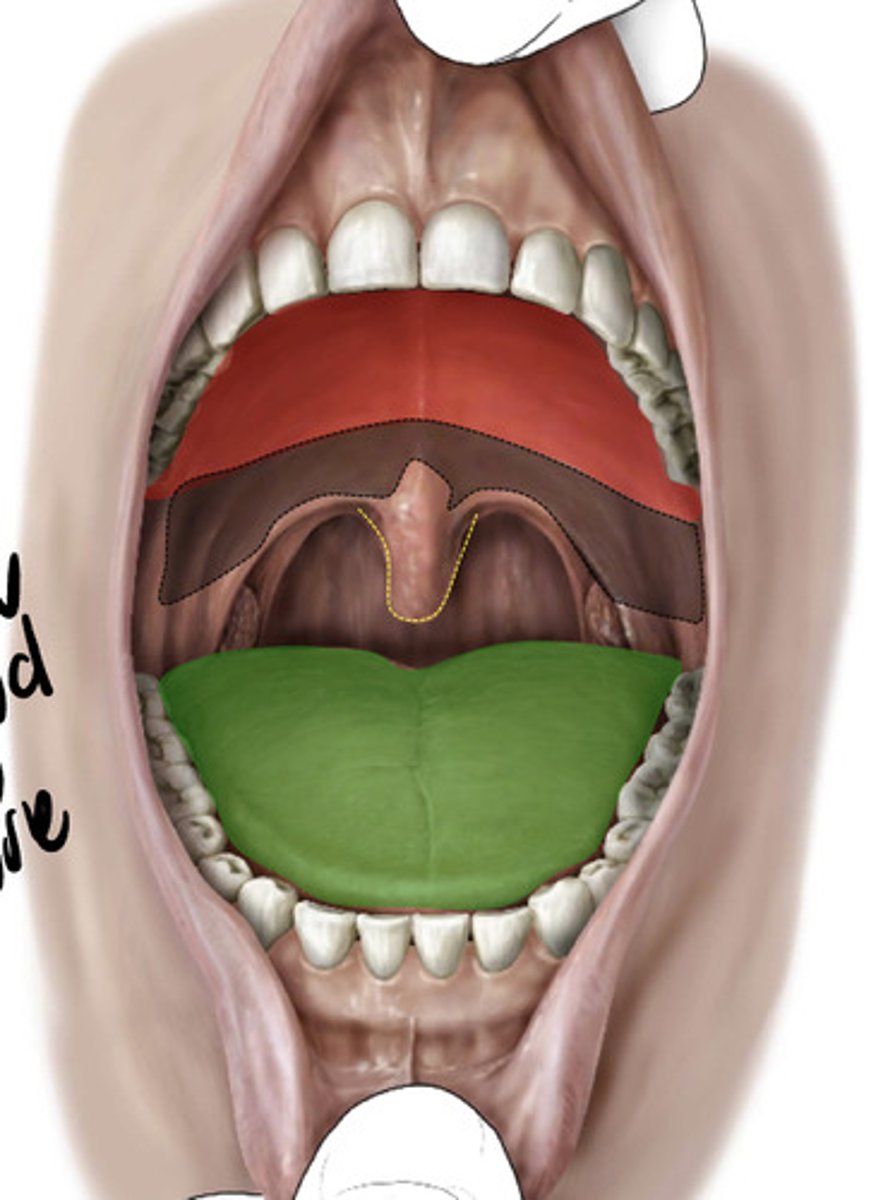
the tip of the soft palate is called what?
uvula
what is the function of the uvula?
elevates to close off the nasopharynx during swallowing
this is the structure that malfunctions when you laugh so hard water comes out of your nose
what is the palatoglossus arch/fold?
this is the first mucosal fold you see in the back of the throat

what muscle is inside of the palatoglossus arch/fold?
the palatoglossus muscle
what are the attachments of the palatoglossus muscle?
soft palate and side of tongue
what is the action of the palatoglossus muscle?
bring two anterior pillars together so food can go down the throat
what is the palatopharyngeal arch/fold?
this is the second fold you see in the back of the throat and its basically palatopharyngeal muscle that is covered in mucosa

what is the attachment of the palatopharyngeal muscle?
soft palate and the wall of the pharynx
what are the actions of the palatopharyngeal muscle?
- pull the wall of the pharynx upward, forward, and medial to shorten the pharynx and constrict the oropharyngeal isthmus by adducting the posterior pharyngeal pillars
what is located between the anterior and posterior arches (anterior being palatoglossus, posterior being palatopharyngeal) ?
the palatine tonsils
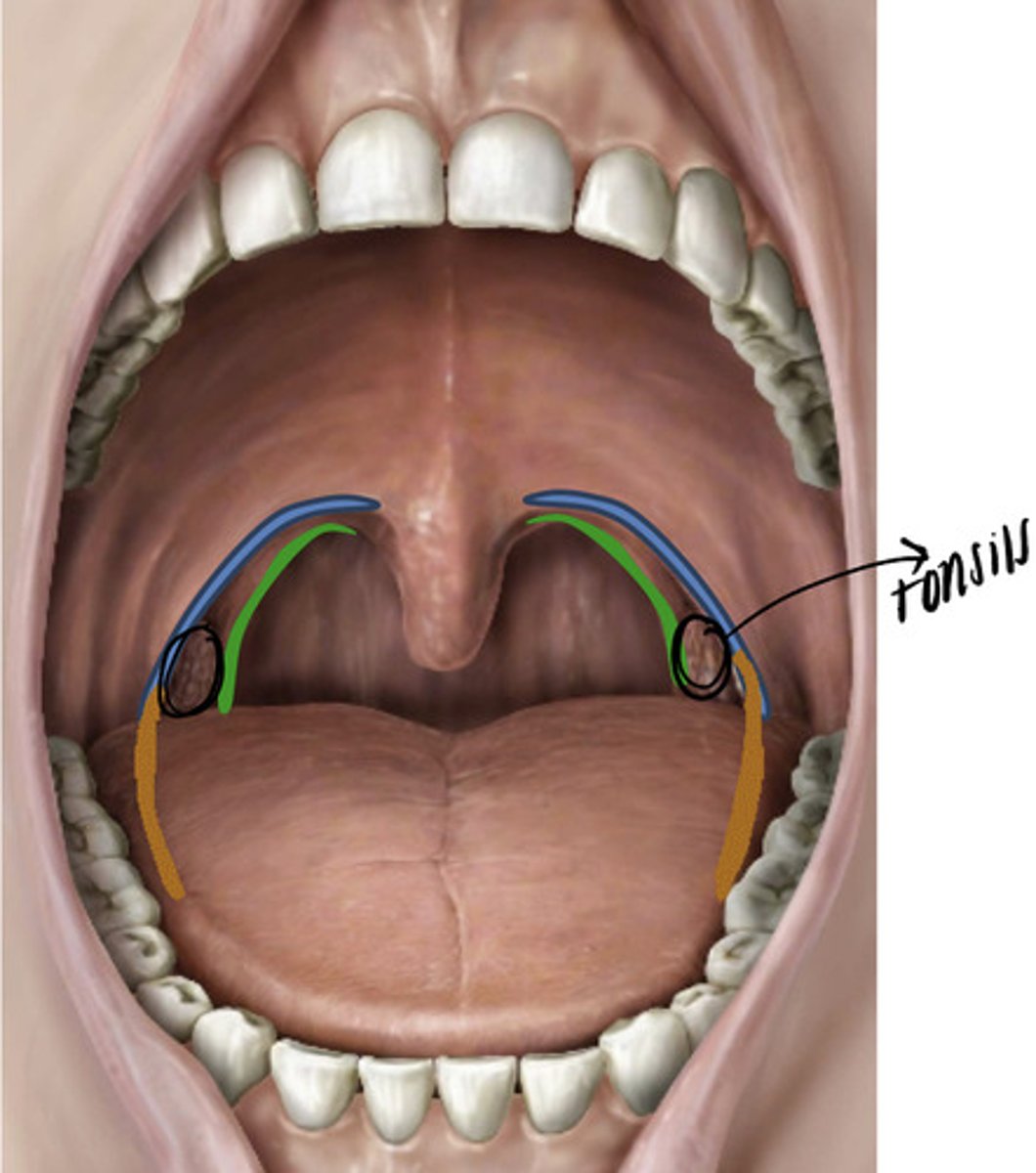
what are the divisions of the tongue?
anterior 2/3: Oral portion
posterior 1/2: Pharyngeal Portion
the sections (oral vs pharyngeal portions) of the tongue are divided by what?
a v-shaped groove called the sulcus terminalis
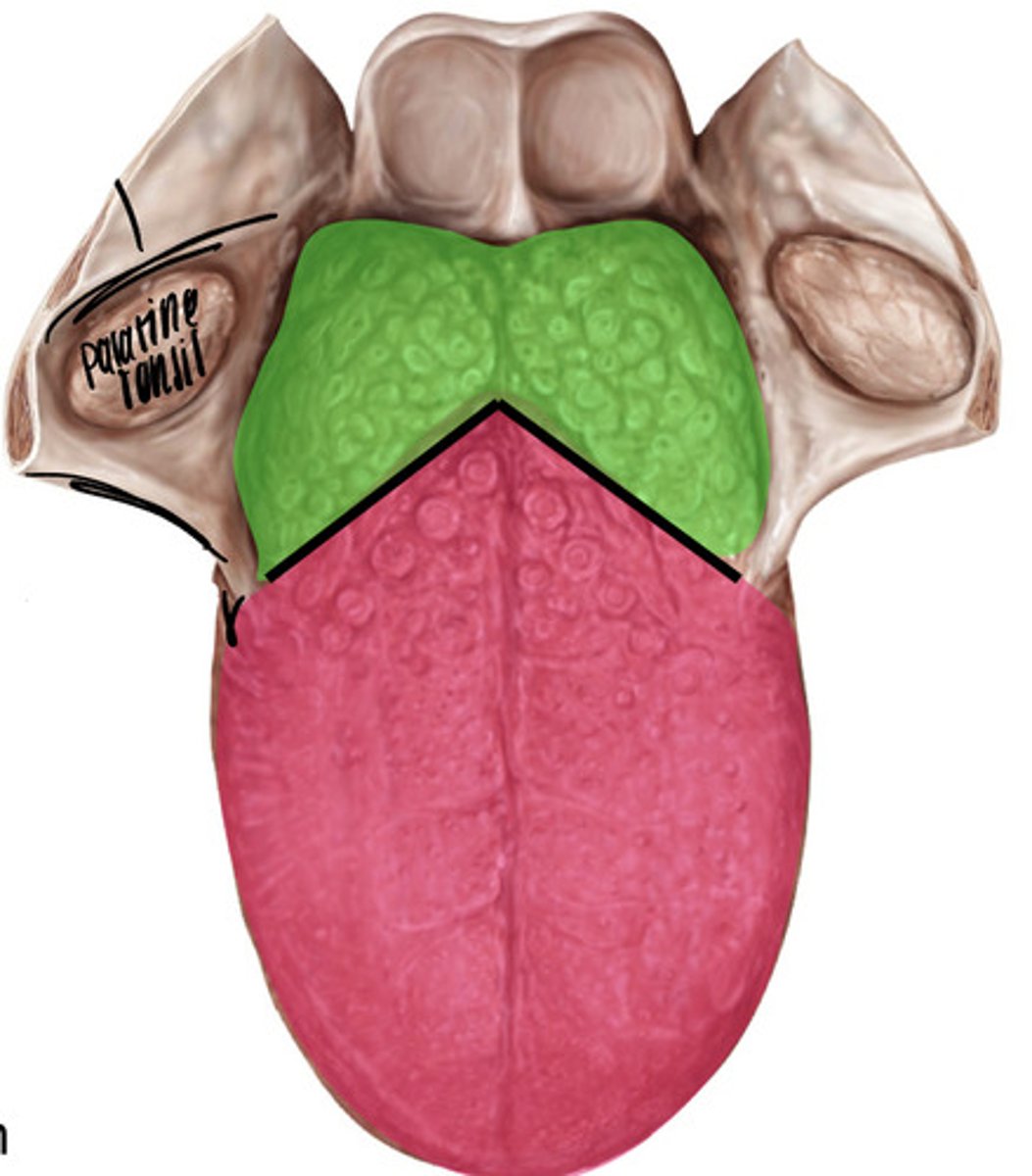
what is the cartilage of the larynx?
epiglottis
what does the epiglottis do?
it closes over the larynx to make sure food doesn't get in when we're eating
what is the attachment of the epiglottis?
attaches to the tongue posteriorly
what is the epiglottis valleculae?
these are your little valleys or spaces between the folds that attach it to the tongue that are pocket like
where can food get stuck to cause chronic bad breath unless treated?
the epiglottis valleculae
what are the 3 folds in the mucous membrane on the epiglottis that attach to the tongue?
- 2 lateral glossoepiglottis folds
- one median glossoepiglottic fold

what covers the dorsum of the tongue and is also known as the taste buds?
the papillae
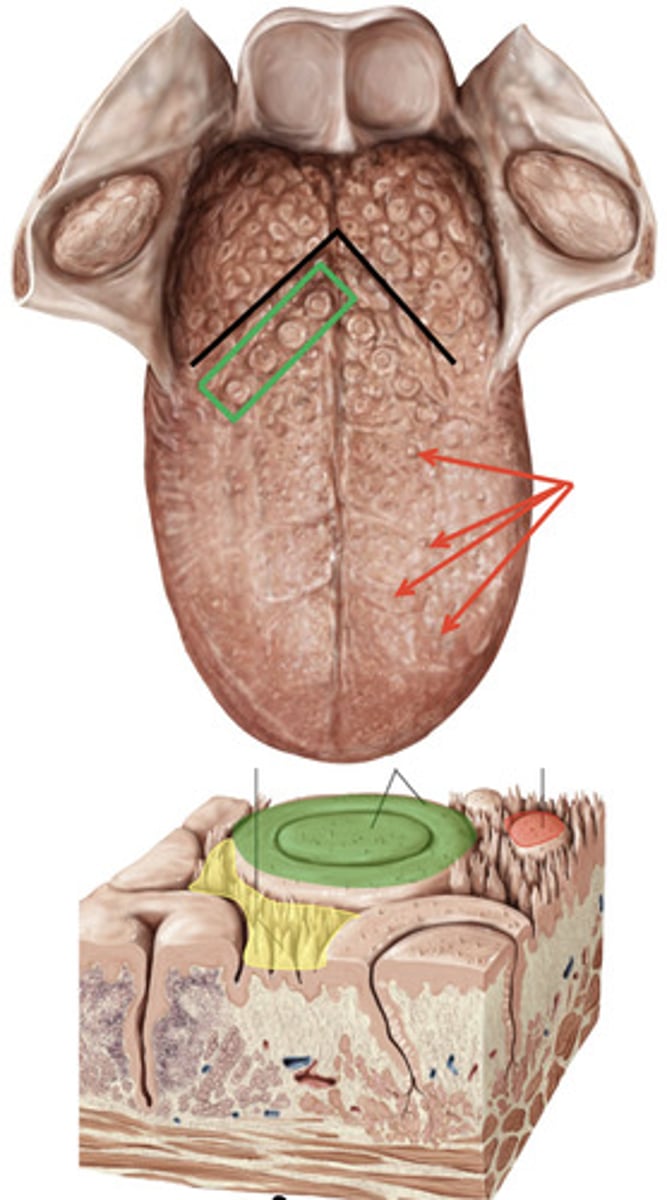
what papillae are the smallest, most numerous, and have keratinized tips to give the tongue its rough texture?
filiform papillae (like the lil hedgehog!)
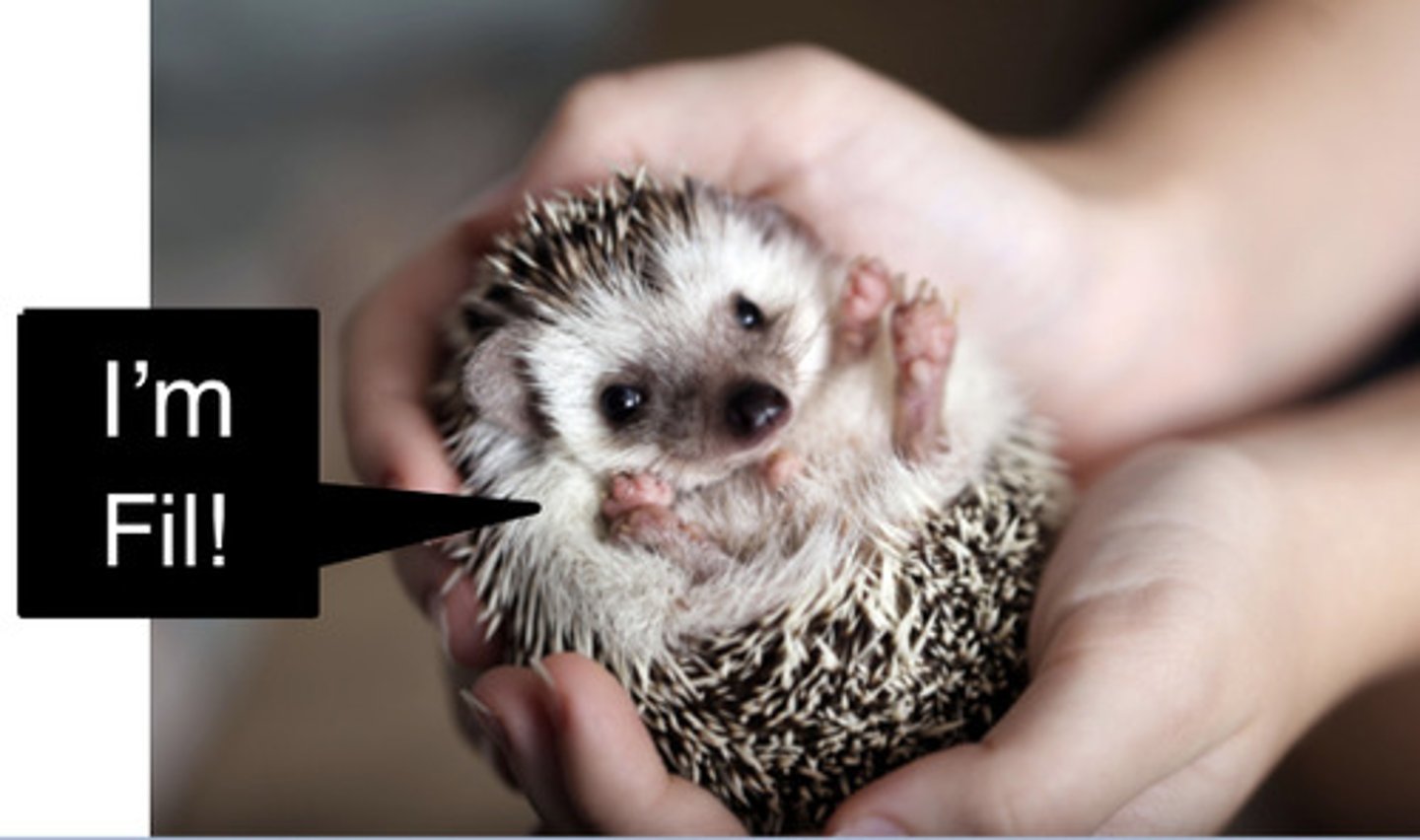
what is the function of filiform papillae?
they are important in sensing the texture of food
what are the mushroom shaped papillae that are scattered widely over the tongue?
fungiform papillae
are filiform papillae or fungiform papillae more abundant/numerous?
filiform papillae
what is associated with the fungiform papillae?
taste buds
what papillae are located directly anterior to the sulcus terminalis that have a little moat around them filled with saliva to wash out food?
vallate (or circumvallate) papillae
what is located on the lateral aspects of the valuate (circumvallate) papillae?
taste buds
what is a leaf-like papillae located along the posterior margin of the tongue?
foliate papillae
what is the site where the thyroid gland develops?
the foramen cecum
where does the thyroid gland go after development?
it descends into the neck via the thyroglossal duct
what are the three things we need to note on the ventral aspect of the tongue?
- frenulum
- orifice of submandibular duct
- sublingual fold
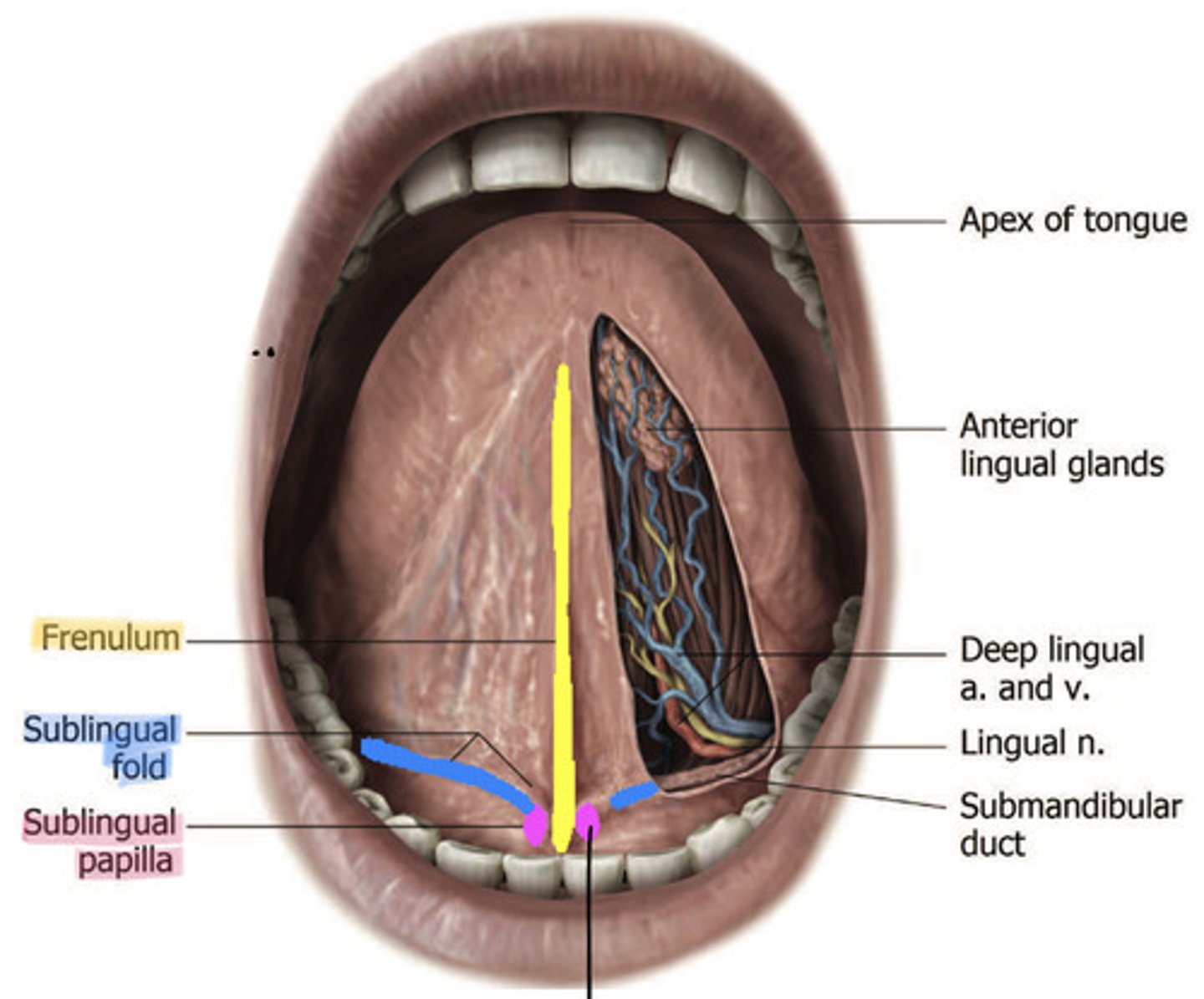
on the ventral aspect of the tongue, what is a midline fold of mucous membrane?
the frenulum
what are the attachments of the frenulum?
tongue down onto the floor
what is a clinical correlate with the frenulum?
this is the place where you can get that congenital "tongue-tie" where your frenulum is too short causing issues with latching in babies as well as lifelong speech impediments if left untreated.
what is located on the submandibular papillae on either side of the frenulum?
orifice of the submandibular duct (salivary gland where we can actually gleet when yawning due to compression on these glands)
dont hate me - but what is the parasympathetic control of those submandibular glands? (think cranial nerves)......
its CN VII btw via submandibular ganglions :)
what is the structure housing the sublingual gland under the mucous membrane?
sublingual fold
dont hate me - but what is the parasympathetic control of those sublingual glands? (think cranial nerves)......
its CN VII btw via submandibular ganglions :)
what gland wraps around the posterior border of the mylohyoid?
submandibular gland
what leaves the deep portion of the gland and passes forward through the sublingual gland beneath the tongue?
the submandibular duct
which nerve goes under the submandibular duct?
lingual nerve
how can you differentiate the submandibular duct from the lingual nerve in lab?
the submandibular duct will be a straight tube with no branching whereas the lingual nerve will dive down and branch
what is located beneath the floor of the mouth that contributes to 70% of our salivary volume?
submandibular glands
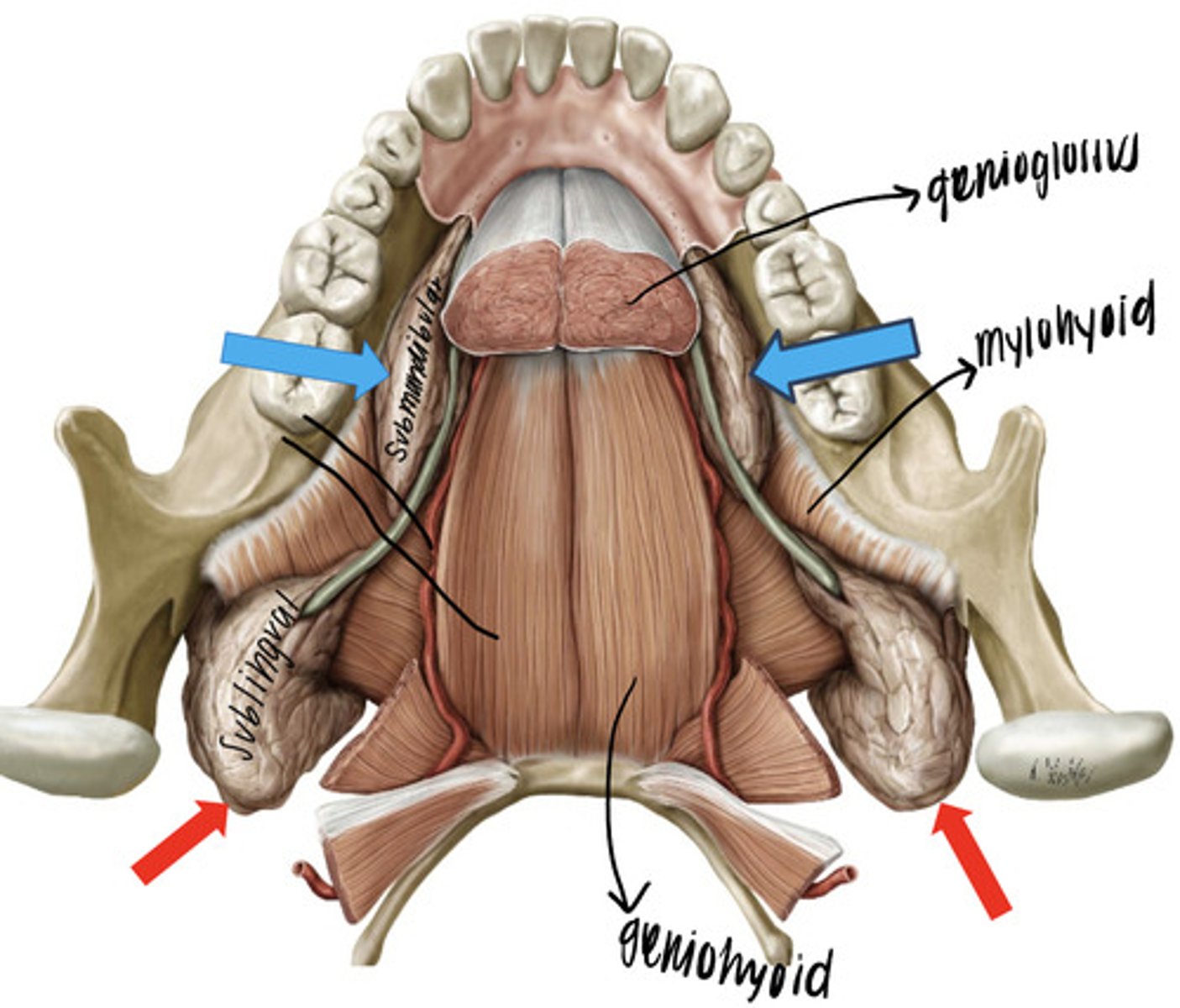
what is located anterior to the submandibular glands, under the tongue, beneath the mucous membrane of the floor of the mouth?
sublingual glands
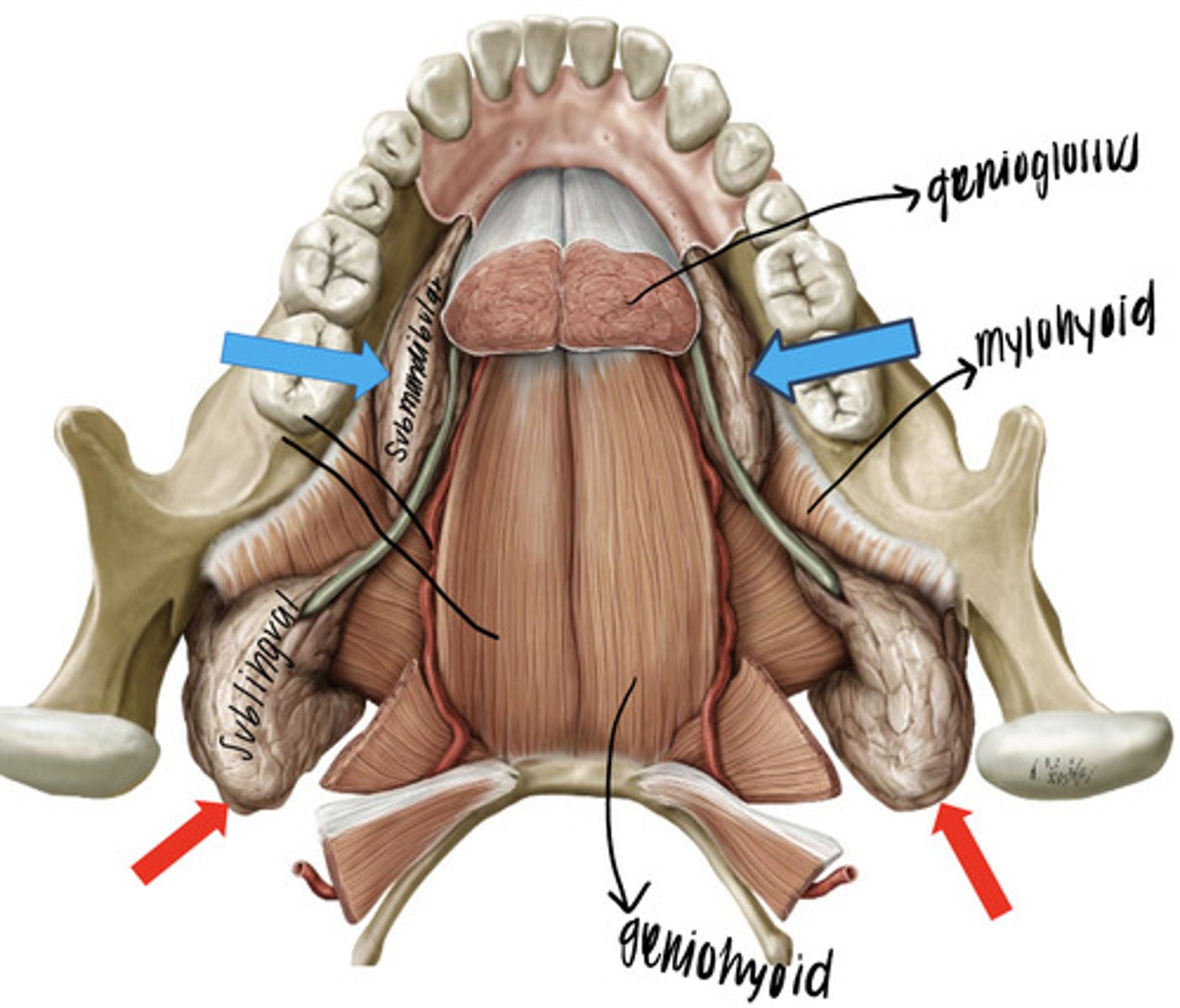
what do the sublingual glands secrete?
a mucous substance that helps to lubricate food
the submandibular gland and the sublingual gland are activated via parasympathetics from what cranial nerves/ganglion?
CN VII via submandibular ganglion
what muscles are located from deep to superficial within the tongue that we discussed? (im discussing deep as in if im looking onto the dorsum of the tongue and going down from there)
- mylohyoid (this is your sling)
- geniohyoid
- genioglossus
the tongue is made up of what muscle arranged into thick fiber bundles?
Skeletal muscle
what are the two types of muscle in the tongue?
intrinsic and extrinsic
what muscles of the tongue are responsible for its form and shape?
intrinsic tongue muscles
what type of tongue muscle DOES NOT attach to bones?
intrinsic
what type of muscle of the tongue originates outside of the tongue and extend to the tongue from bones of the skull or soft palate?
extrinsic muscles
that are the functions of the extrinsic muscles of the tongue?
- protrusion of tongue
- retraction of tongue
- lateral movement of tongue
the tongue is a mass of skeletal muscle that functions in what four things?
1. Taste
2. Mastication (chewing)
3. Swallowing
4. Speech
what is the tongue anchored to?
the styloid process, hyoid bone, mandible, and palate
what is a fan shaped extrinsic tongue muscle that attaches to the superior genial tubercle (also called superior mental spine) up to the intrinsic muscle mass of the tongue?
the genioglossus
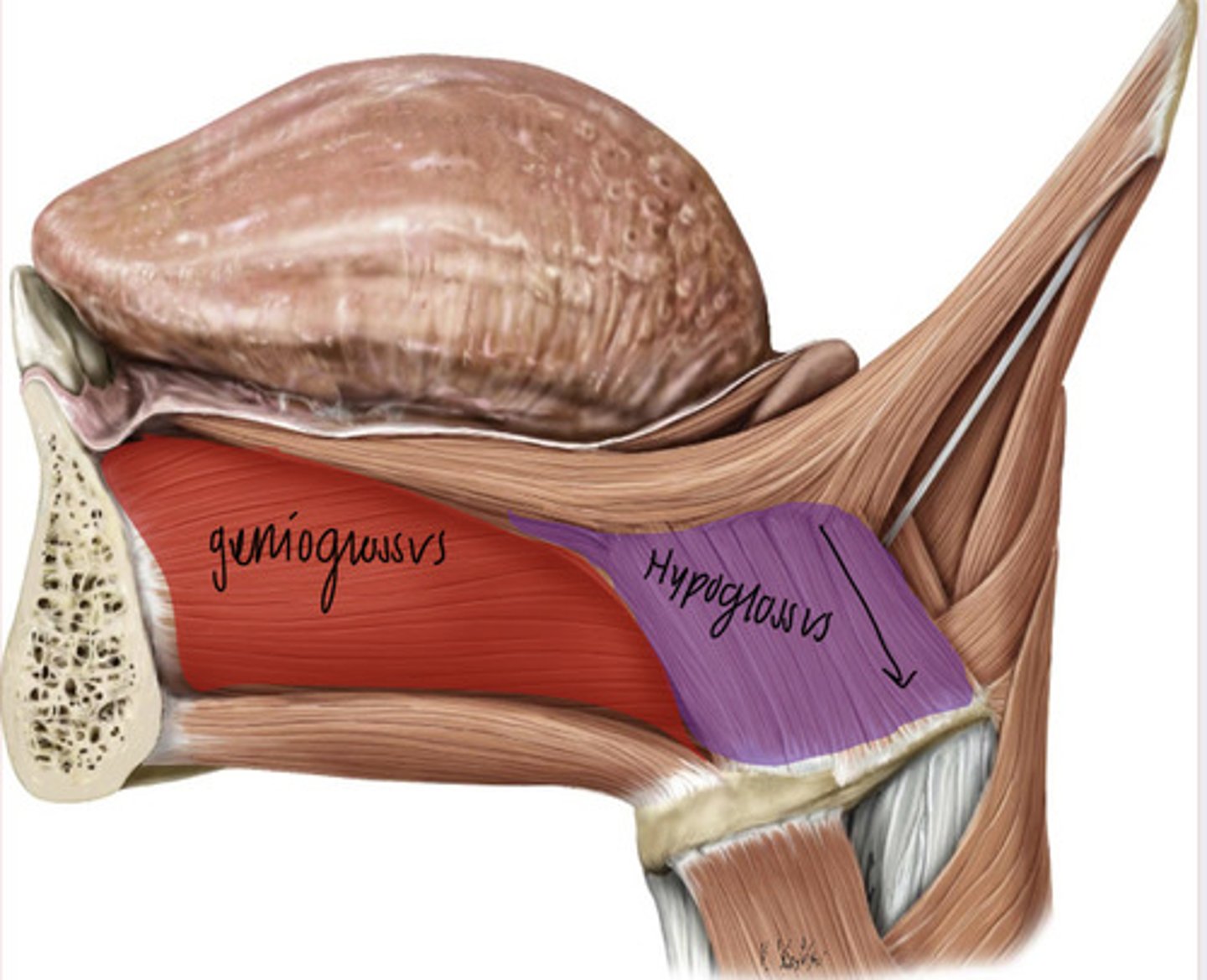
what is the action of genioglossus?
to pull the tongue forward to protrude the tip and depress the medial region to make the surface concave
what is the innervation to the genioglossus muscle?
hypoglossal CN XII
what is a flat quadrangular extrinsic tongue muscle that attaches to the hyoid into sides of the tongue?
hypoglossus

what is the action of hypoglossus?
this is a depressor of the tongue that can also retract the tip of the tongue
what two structures pass deep to the posterior border of the hypoglossus?
the glossopharyngeal nerve (IX) and the lingual artery
what is the innervation to the hypoglossus?
hypoglossal nerve (CN XII)
what extrinsic muscle of the tongue passes up into the soft palate within the palatoglossal fold?
palatoglossus

what is the attachment of palatoglossus?
soft palate and tongue
what is the action of palatoglossus?
constricts the oropharyngeal isthmus by bringing the two anterior pillars (PG folds) together in the midline, closing off the oral cavity from the oropharynx.... in simple terms it closes off the throat
(it also elevates the root of the tongue)
what is the innervation to palatoglossus?
THIS IS THE HYPOGLOSSAL EXCEPTION!
its innervated by VAGUS nerve! (this is via the pharyngeal plexus via CN X)
what extrinsic muscle of the tongue arises from the styloid process and passes into the lateral aspects of the tongue?
styloglossus

what is the function of styloglossus?
retractor of the tongue
what is the innervation of styloglossus?
Hypoglossal CN XII
the blood supply to the tongue is via which artery?
lingual artery
where does the lingual artery come from?
the external carotid between the superior thyroid and facial artery, below the hyoglossus and between the geniohyoid
what gives us taste and general sensory to the most posterior aspect of the tongue (like where the epiglottis is)
Vagus Nerve
what give us taste and general sensory the posterior 1/3 of the tongue behind the sulcus terminalis?
glossopharyngeal
what gives us taste to the anterior 2/3 of the tongue in front of the sulcus terminalis?
facial nerve CN VII
what gives us general sensory to the anterior 2/3 of the tongue in front of the sulcus terminalis?
lingual nerve CN V
facial nerves rides with what other nerve?
lingual nerve
what is the lymphatic Flow left vs right from the neck?
- regional lymph
- deep cervical lymph
right: right lymphatic duct
left: thoracic duct
- both to internal jugular
- to then subclavian
- to end in superior vena cava
the tip of the tongue drains to what nodes?
submental nodes
these are located In which triangle of the neck?
.... located in the submental triangle
the anterior 2/3 of the tongue drains to which nodes?
submandibular and deep cervical nodes
the posterior 1/3 of the tongue drains where?
deep cervical nodes